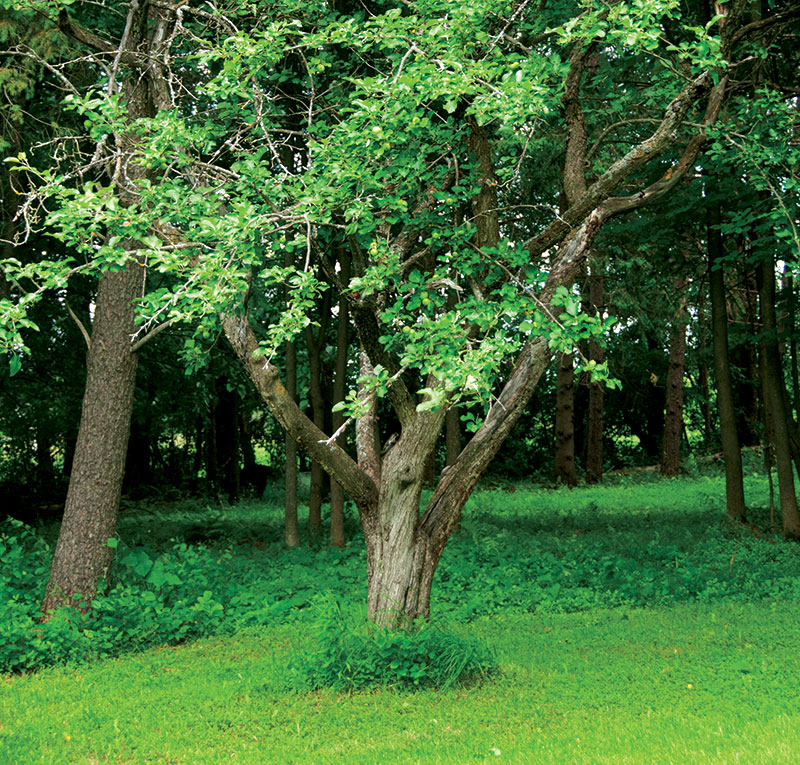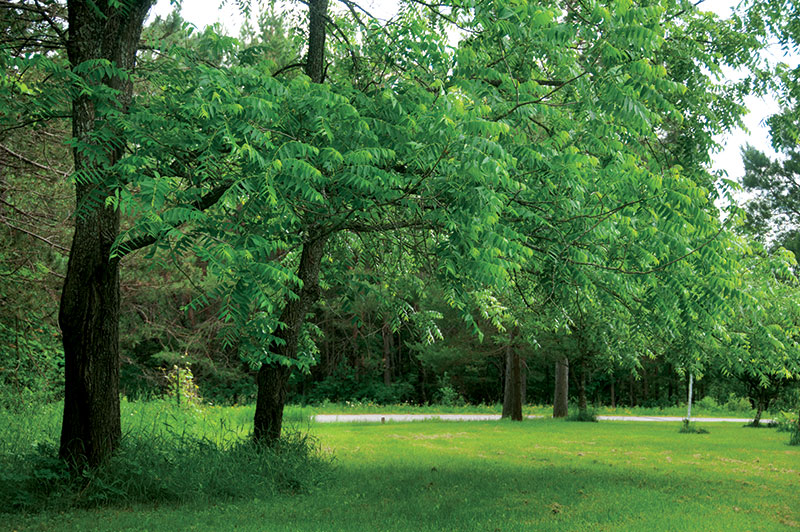
The cold winters in the northern regions of the United States offer plenty of challenges for farmers. All-too-brief summers and long, cold winters create short growing seasons that are challenging for growing gardens and orchards, so you can understand why southern locales appeal to a lot of farmers. Isn’t it punishment enough to deal with the long winters without having to compromise on your aspirations for impressive fall harvests?
But never fear, northern farmers. While you might not be able to grow orchards full of pecan or peach trees, you can grow a remarkable variety of fruit and nut trees in the northern states—so many that there’s really no need to feel limited. By choosing appropriate cold-hardy varieties and putting careful thought into where you plant trees in your orchards, you can create a vibrant stand that will produce fruit and nuts for years to come.
How Cold Is Defined
How do you know whether a particular type of tree can survive the cold weather where you live? While many factors can influence the equation, the best place to start is with the USDA Plant Hardiness Zone Map. This colorful map of the U.S. divides the 50 states (as well as Puerto Rico) into a series of numbered zones ranging from 1 (the coldest) to 13 (the warmest), based on the average annual extreme minimum temperature each year.

If you live in zone 7 or warmer, you can expect that the coldest temperatures of winter won’t dip below 0 degrees Fahrenheit, ideal for growing a wide variety of orchards of fruit and nut trees. But once you get down to zone 4, you’re talking about winter temperatures that can fall to minus-20 to minus-30 degrees. It gets even worse in zone 3 (minus-30 to minus-40) and zone 2 (minus-40 to minus-50). Now that’s cold!
While you might question how any orchards could survive such extreme winter temperatures, zone 4 supports an extensive range of fruit and nut trees, while particularly hardy specimens can tolerate even the conditions in zone 2, especially if you give them an edge with careful planting considerations. To find out your zone, visit this USDA map.
Help Your Trees Survive
Within the broad categories of the plant hardiness zone map, local microclimates exist that are warmer or colder, and these microclimates can exist even within your own acreage.
For example, the differences between a south-facing slope and a north-facing slope can be significant. In theory, you might assume that a south-facing slope would be more ideal for cold-sensitive plants because it provides more direct sunlight. But this also means that temperature swings on southern slopes are more extreme, which can cause sunscald (damage to the trunks of trees from rapid temperature fluctuations) and premature awakening from dormancy (which can cause damage to delicate trees if temperatures suddenly drop again). Planting on the south side of a stone wall or building can produce similar effects.
For orchards of truly hardy trees, a south-facing slope can be perfect, but if you want to grow a tree on the edge of its range, the tree might be better off on a north-facing slope, where temperature swings will be moderate and spring awakening delayed.
The direction of prevailing winds is also an important consideration, because cold winter winds can further decrease temperatures in a given area. Having some form of windbreak, whether it’s a building or rows of windbreak trees, can provide a more sheltered area for your orchards. Just make sure that your windbreak won’t shade the orchard too much during the summer months, when long hours of direct sunlight are paramount.
Wrapping the trunks of your trees with tree guards to protect against sunscald can also help, and it’s a good idea to avoid pruning your trees late in the year, as there is evidence that this can reduce their ability to prepare for cold temperatures and cause damage as a result.
What About Mulching?
While mulching the trees in your orchards won’t protect branches from damage, it can help protect the roots and ensure the long-term health of the tree. Even if you encounter an abnormally severe winter that damages branches and fruiting wood, the layer of mulch might be enough to save the roots and allow the tree to bounce back. Straw, pine needles and leaves can all perform well as cold-weather mulching material. For winter protection, the layer of mulch should be a few inches deep (in the case of straw, perhaps more) and as wide as the tree’s canopy overhead.
Consider These Fruit & Nut Trees
If you’re fortunate enough to live in zone 4, your options for fruit and nut trees and orchards are pretty broad. Zone 2 and zone 3 reduce the possibilities for growing an orchard of nut trees, but the hardier varieties of fruit trees ensure that you can still produce an impressive harvest each fall. Let’s look at some of the more popular cold-hardy trees you can consider.
- Apple Trees: As perhaps the most quintessential and popular fruit tree, apple trees have been meticulously bred and developed for years, and lots of options exist for cold-hardy varieties. There are far too many to list, but Duchess of Oldenburg (whose apples are pictured at the top of this post), Wolf River and Red Gravenstein are three heirloom trees that perform well into zone 3 (and in the case of Red Gravenstein, even zone 2), while September Ruby—developed in Canada and introduced in 1986—can be resilient all the way into zone 1. Wolf River is a particularly fun tree to grow because it’s known for producing huge apples, though they’re better suited to cooking than fresh eating (which is a nice way of saying that they’re a bit sour or tart). In this regard, Duchess of Oldenburg (whose tree is shown below) is a tastier choice for orchards.

J. Keeler Johnson - Pear Trees: You’ll find that cold-hardy pear trees aren’t as common as cold-hardy apple trees, but the Ure is considered an excellent option for tasty pears as far north as zone 3, though it needs cross-pollination with another pear variety—such as cold-hardy Siberian and Golden Spice—in order to bear fruit. Patten is known for its large fruit and is also an option for zones 3 and 4.
- Plum Trees: Options abound for hardy plum trees, including Toka, Black Ice and Waneta, all of which are resilient into zone 3. Pembina is even hardier, surviving and thriving into zone 2, though it has a reputation for needing a different plum species growing nearby for pollination purposes. Fortunately, the tried-and-true American and Canadian plums—two native species—can do the job just fine and are also very hardy.
- Cherry Trees: Not all cherries are equally tasty when eaten fresh, but hardiness isn’t much of an issue. As you might expect of a cherry tree developed in Saskatchewan, the Carmine Jewel cherry can be hardy into the warmer regions of zone 2, as might the popular Nanking cherry, though it could prove more comfortable growing in zone 3. Also resilient is the widespread chokecherry, which grows wild throughout the northern U.S. and well into Canada. Despite its somewhat off-putting name, A Field Guide to Eastern Trees (part of the Peterson Field Guide Series) notes that “the tart fruits” of chokecherries “can be made into delicious jellies and are used for pies.”
- Shagbark Hickory: A close relative of the pecan (so close that pecan/shagbark crossbreds can be found), shagbark hickory is considerably hardier than its warmth-loving southern relative and can perform well into zone 4. Summer and fall versions of the shagbark hickory are shown below.

Shutterstock 
Shutterstock - Black Walnut: Renowned for their tasty nuts and value as lumber trees, black walnuts (shown below) are reasonably hardy but might not thrive in the coldest of climates. They can survive as far north as zone 3 (the three walnuts in my orchard are proof), but they struggle to produce nuts in these conditions (mine are proof of this as well) and prefer the slightly warmer winters of zone 4.

J. Keeler Johnson - Butternut: If you want to grow walnuts but are concerned about cold winters, the butternut can be a great compromise. Butternut trees are very similar to walnuts and are, in fact, frequently referred to as “white walnuts.” Their general range runs a bit farther north than walnuts, and they’re hardy into zone 3.
- Chestnut: Chestnut blight might have decimated the Native American chestnut, but the disease-resistant Chinese chestnut is a great alternative, surviving as far north as zone 4. The hybrid Colossal chestnut is likewise hardy to zone 4.
What About Citrus in Cold Climes?

Not quite satisfied with the apple, pear, plum and nut trees that you can grow in cold-weather regions? If it’s citrusy flavor that you crave, is there a way to grow oranges or lemons in the colder zones of the country? The short answer is no, if you use traditional means. The long answer is yes, if you’re willing to put in some effort.
Because citrus trees won’t tolerate temperatures below freezing, they won’t survive a single winter if you plant them in the ground and subject them to the bitter cold found in the north. However, citrus trees planted in large pots can be brought indoors during the winter, where—if kept by a sunny, southern window—they can survive and thrive for years.
Of course, citrus trees grown in pots do require special care. As they grow, you’ll either have to transfer them to larger pots to prevent the trees from becoming root bound, or you’ll have to trim back the roots and the leaves in an effort to keep the tree from growing beyond a particular size—which might be ideal anyway because moving a large tree indoors for the winter can be difficult.
In addition, you’ll have to be careful to prevent your citrus frees from overproducing fruit, which can be detrimental to their health. You won’t get giant crops of fruit from citrus trees, but if you’re willing to give them the care and attention they need, you can expand the number of different fruit trees that you can grow in your region.
You might not live down South where temperatures are warm and winters mild, but by choosing cold-hardy specimens and giving special consideration to planting location and winter care, you can grow a productive orchard as far north as zone 2. Have fun planting!




